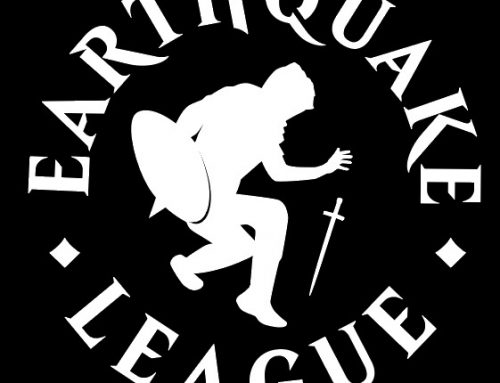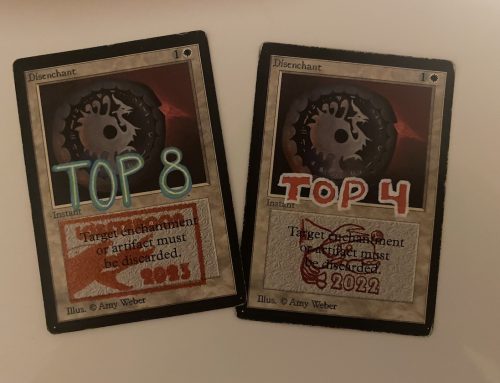BAXTER IN X-POINT: DECK MUSINGS AND TOURNAMENT REPORT
By Thomas Sutherland
I have been off webcam games for a while. Being active in the online tournament scene was easy during lockdown; but life had other plans for future me, including a daughter, a new role at my job and relocating with my family some 7,800 miles to another continent. My availability to battle in the plane of Dominia is not what it used to be. Last time I made top 8 at a NEOS monthly was in February of 2022, and that was X-Point; so it was a nice coincidence that the triple entente of unanswered emails, toddler meal prep, and my wife’s DIY projects began to relent just when Jared announced that the August 2023 NEOS monthly would be the same format.
Back in February of 2022 I played a Tax-Edge build that cruised through the group stage but fell short to Mano’s Arabian Aggro in two weird games, which included a miser’s Force Spike countering an otherwise game-winning Land’s Edge.
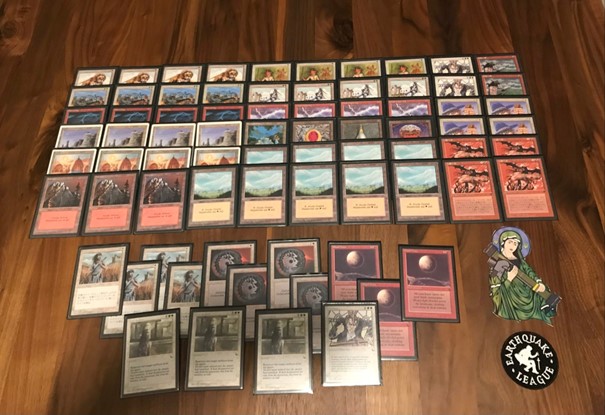 February 2022 Tax-Edge.
February 2022 Tax-Edge.
I somehow decided to not play a land for the turn in which I tapped out to try to kill Mano, despite playing with open deck lists. Maybe bringing his life total to -4 instead of -2 seemed like the best possible play. Maybe not. I guess it sucks to suck.
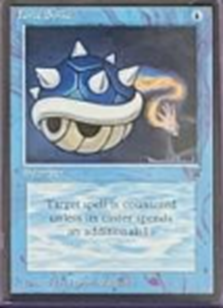 Dodge this.
Dodge this.
I really enjoyed playing with Tax Edge, so revisiting it was an appealing proposition; even if Land Tax now was two points apiece, as a playset and a Mox Pearl is all the deck really needs to tick. However Andrés mentioned to me that a gang of Juzám Djinns had yet to take home an X-Point trophy, and we agreed that it needed to change. Hymn to Tourach’s point costs had just been halved, so between that and our commitment to play with the grinning 5/5 we had a good piece of marble to start sculpting away.
THE DECK
Andrés and I had two different approaches to the deck. He was pushing for a midrange-oriented build with less creatures and a better suite of solid answers, similar to his back-to-back Lobstercon top-8 list. White had a predominant role, with Swords To Plowshares making as its main source of removal. I wanted to take a more aggressive route, with more low-to-the-ground threats, Dark Ritual and a higher concentration of red. The main points of disagreement were (i) I wanted to play Black Knight as a cheap threat that could leverage Lightning Bolt. Andrés didn’t want to go near it because it is a bad Magic card; (ii) I wanted to play Dark Ritual to accelerate Hypnotic Specter and Juzám Djinn. Andrés thought it was card disadvantage and a lousy topdeck; and (iii) I wanted to play Blood Moon in the sideboard to shut down greedy mana bases, Deserts and Mazes, but Andrés had just played a Blood Moon deck in the Summer Derby and wanted a break from the cheesy enchantment.
We went back and forth for several days and agreed to play the following list.
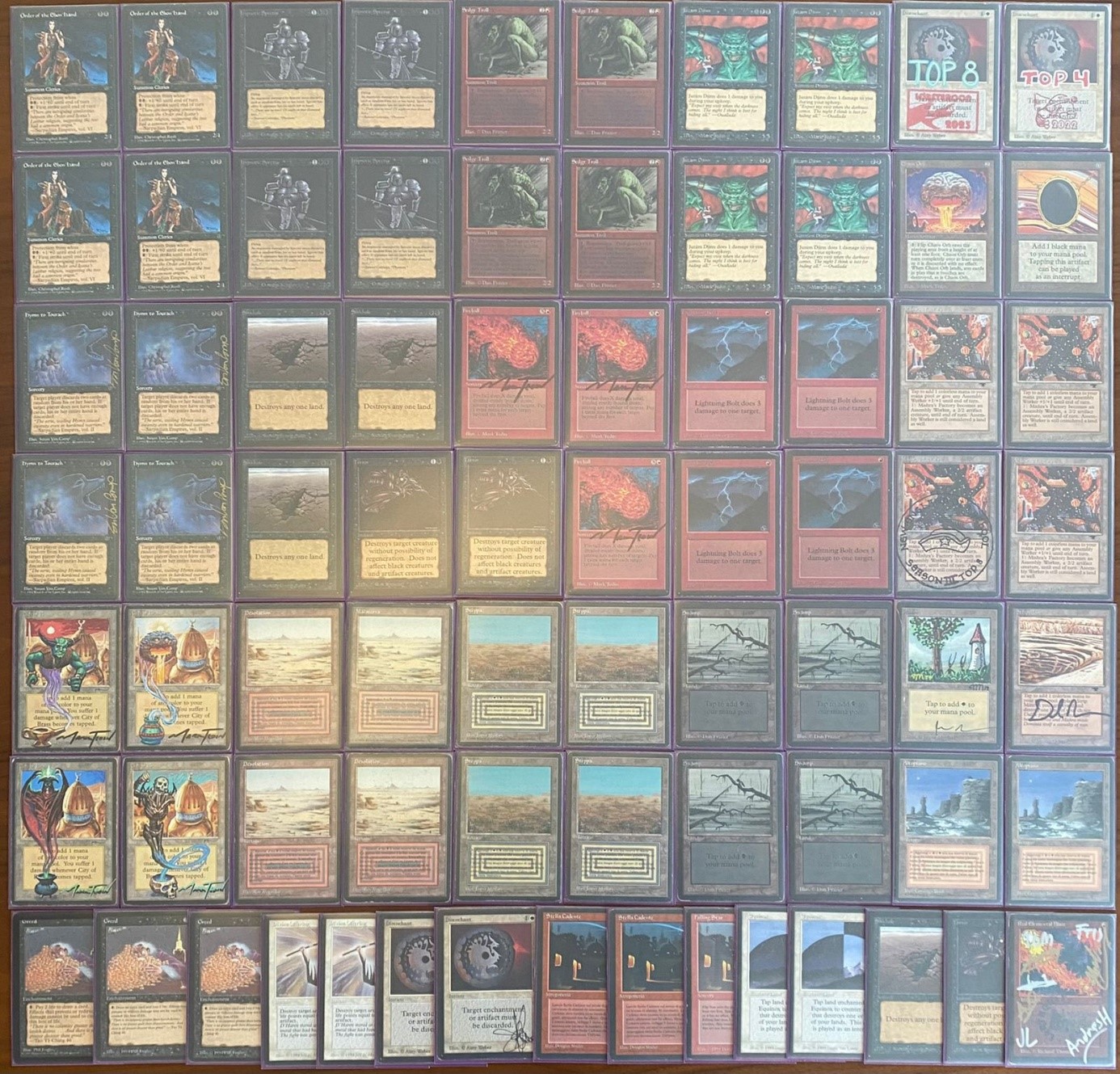
Andrés was already off to the races and had begun playing his matches, but I was still unconvinced that I wanted to play the list. The amount of black mana seemed insufficient, and it felt slow and clunky. The deck was good, but it didn’t feel good enough, and I hesitated to play my first monthly tournament in a long time with a list that was not near and dear to my heart.
When building a deck it is usually wise to seek inspiration in the old classics, and it doesn’t get more old or more classic than George Baxter. He was one of the game’s first authors and theorists, publishing books like Mastering Magic Cards, Baxter on Magic, and Deep Magic. In the first ever Pro Tour, Baxter secured the first place in the Swiss playing a list he baptized as House Of Pain II, being the only player with a perfect record (7-0), beating Thomas Andersson’s Necro deck in the final round of the swiss.

George Baxter’s House Of Pain II – Pro Tour New York 1996
Baxter managed to win his round-of-sixteen match against Jim Lemire, but ended bowing out to Leon Lindback’s Necropotence in the quarterfinals. He went on to have a string of top finishes at high-level events, including a semifinals appearance at Nationals 1996, and a second PT top 8 in Dallas that same year. But success came with a cost: losing his girlfriend and neglecting school. He later decided to enroll in law school and get his girl back, quitting competitive Magic forever.
A modern critique on Baxter’s work and tournament performance can be scathing. His books are superficial at best and almost comical by today’s standards. His deckbuilding choices could also be considered questionable, with blunders such as not playing Necropotence in House Of Pain II. This position is unfair. It is true that Baxter’s books generally failed to identify the theoretical conceptualizations of the modern game’s building blocks like Brian Weissman did when writing about card advantage or Eric Taylor when he explored the concept of tempo in Usenet channels. But Baxter’s work did contribute by exploring different deck archetypes such as aggressive weenie strategies, and selecting cards according to common mechanical themes to maximize redundancy for effect, such as hand denial (discard) or countermagic. A lot can also be said about his deckbuilding prowess. His prison decks for US Nationals and PT Dallas were interesting and innovative ways to attack a metagame with the limited information of a pre-internet era. House Of Pain II passed on Necro but so did almost everyone, except some savvy Swedes, a kid from California called Graham Tatomer, and a select few. What is particularly noteworthy of this list is that it intuitively applied several key theoretical concepts of successful modern deckbuilding, years before they were distilled. The mana-base seems primitive, but with 23 lands and 18 black-mana producing lands he was not so far off modern builds developed with hypergeometric analysis that allowed it to play its spells every turn. It even eschews forests to negate Erhnam Djinn’s drawback! The spell distribution resembles a modern mana curve, months before Jay Schneider pioneered the concept. But what is perhaps the most remarkable design aspect of House Of Pain II is that it just played good cards. Cards that were good in turn two or twelve of the game. Cards that were good against any opposing strategy, intuitively applying a theory of threats and answers before David Price and Mike Flores would distill it and put it on paper three years later.
Many of the key principles that made House Of Pain II successful in Pro Tour 1 can be applied to X-Point. Limitations to fast mana and busted restricted cards that are commonplace in old school create a creature-heavy meta that was relatively similar to the one played in that event. This made it the perfect starting point to build an X-Point deck that could take advantage of Hymn To Tourach and could fit Juzám Djinn. It was also a good opportunity opportunity to pay homage to Baxter’s ingenuity in the dawn of competitive magic. This is what I ended up with:
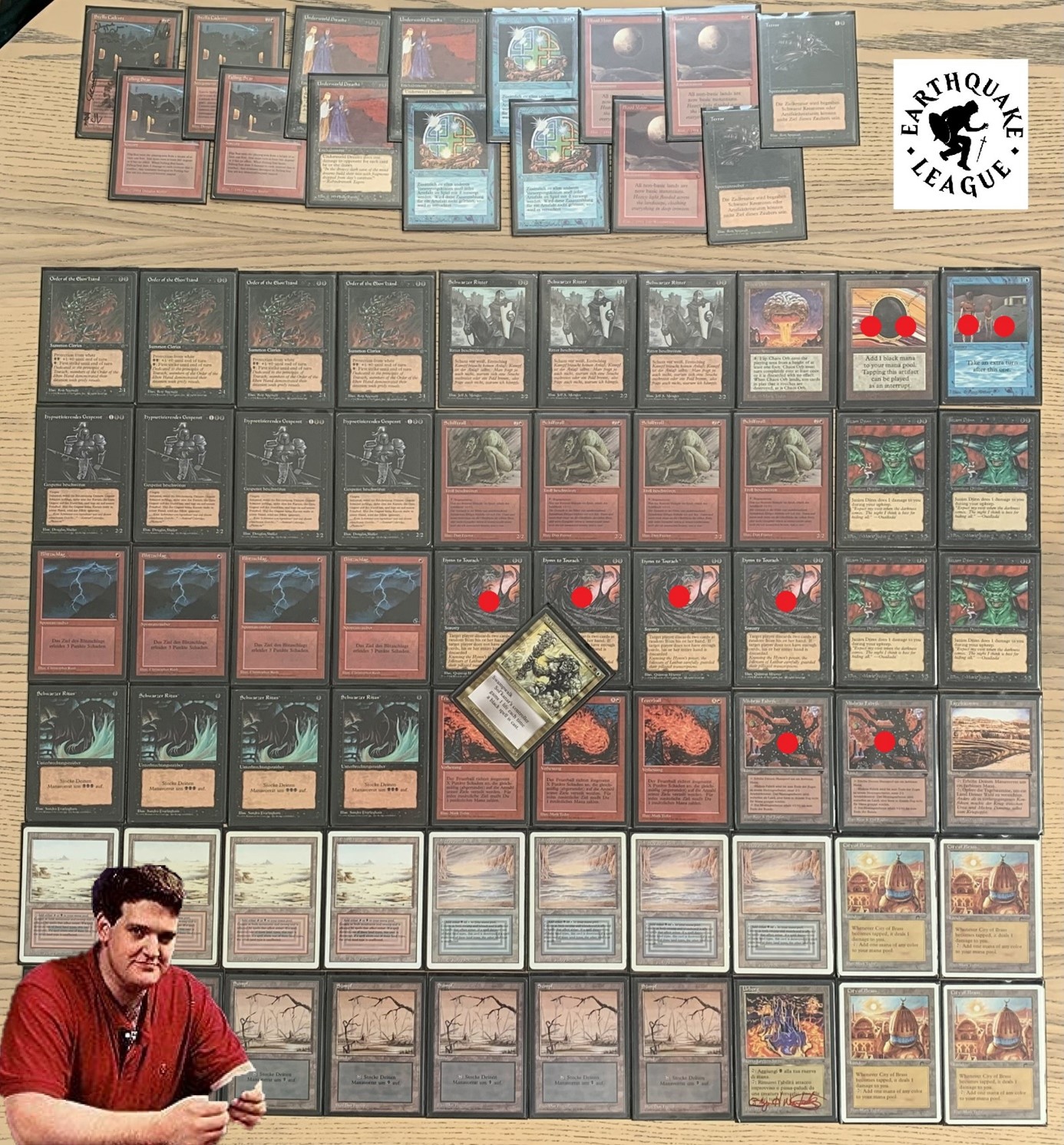 August 2023 Baxter
August 2023 Baxter
NEOS AUGUST 2023 MONTHLY REPORT
Match 1 vs Joe Becica, playing Mono White Control. Joe and I had a nice pre-game chat about his ATC episode on X-point and how it was an interesting way to approach the format. Highly recommended content. On game one I Hymn away a Wrath Of God and then proceed to chip away Joe’s life total with some Pro-White Knights which he is unable to answer. Game two is almost a carbon copy of the previous game, with Sol Kannar leading the charge.
Sideboard: -4 Bolts, -2 Rituals; +3 Moons, +3 Dreams.
Match 2 vs Jesús Mancilla, playing Goblins. Jesús gets stuck on one mana and tries to put up a fight, but playing one goblin a turn is no match against a steady flow of superior creatures. On game two he deploys several waves of goblins and a Goblin King, but I wipe them out with multiple Falling Stars, and then turn the corner with Sedge Trolls.
Sideboard: -4 Juzám Djinn; +4 Falling Star
Round 3 vs Mike Scheffenacker, playing The Deck. Michael stumbles on mana and I start beating him with an Order and a Black knight, which prompts him to quickly concede. On game two I try play an early Order and start attacking him, which forces him to Wrath Of God. I resolve an Underworld Dream which he disenchants. After that I manage to play more creatures which he keeps at bay with multiple Deserts and a Maze of Ith. I eventually draw a Badlands that allows me to play two Blood Moons which shuts down his defences, clearing the way for my creatures and finishing him with a Fireball.
Sideboard: -4 Lightning Bolt, -2 Dark Ritual; + 3 Blood Moon, +3 Underworld Dreams.
Match 4 against Rich Shay, playing White Weenie. I drop my first game of the tournament against Rich after mulliganing to five and not being able to have a quick response to his Savannah Lions and Order of Leitbur. In game two Rich presents several threats but I manage to gain the upper hand with two Hymns and a Fireball, and then close out with Sedge Trolls. On game three I start off strong by Ritualing out two Black Knights and follow up with a Time Walk to get ahead on the damage race. Rich stumbles on mana and is unable to close the gap.
Sideboard for both games: -4 Juzám Djinn; +4 Falling Star
Match 5 vs Tim Moran playing Blue-Red Burn. An early Chaos Orb cripples Tim’s anemic mana base, and my guys swept him over. On game two I manage to pressure his life total a quick Juzám and some smaller creatures. He tries to stop the bleeding with a Serendib Efreet, but a Terror clears the way. He casts a Wheel Of Fortune to try to stabilize, but I draw a hand that allows me to Ritual out a Juzám, play a knight, and then cast Time Walk for a winning attack.
Sideboard: -2 Fireball; +2 Terror
Match 6 vs José Luis Capdevila, playing Tax Edge. José Luis and I are good friends, so we decide to play in person while he was borrowing some cards at a friend’s house for a Pioneer tournament. We play three full matches and I manage to win two of them, mostly on the back of Mox Jet, Knights, and burning his pro-black guys.
Sideboard for all post-board games: -4 Juzám Djinn; +4 Falling Star.
Quarterfinals vs Franta, playing Black-Red Aggro. On game one I hymn Franta’s only lands from his hand and he doesn’t draw another one before my guys reduce his life total to zero. Game two is very grindy, but he gains the upper edge by killing one of my Juzams with a Blood-Lusted Black Knight (nice) and then reanimating the Djinn with Animate Dead (very nice). I try to stabilize with a Sedge Troll, but he rips a Terror from the top and sends me packing. Game three is a blur, but I believe that he stumbles on mana, and I manage to make it worse by Orbing one of his resources and hitting it with the edge of the sleeve while putting some pressure with a Sedge Troll that takes him down to low single digits. He manages to recover by hymning a Juzám and reanimating it, but I respond with a second Sedge Troll, and then following up with a Falling Star that taps out his board, clearing the way for a lethal attack.
Sideboard: -1 Order Of The Ebon Hand, -1 Sol’Kanar, -1 Dark Ritual; +3 Falling Star.
Semifinals vs Jared Miller, playing Blue-Red Shops. Of all the decks that made the knock-out stage, I feared Jared’s blue-red Shops the most, as his guys are bigger and I struggle to deal effectively with most of his permanents. I Double mulligan on game one and try to claw back with a Hymn and some small creatures, but he leverages Shops to ramp out a Trike and a Tetravus that mow me down pretty quickly. On game two Jared starts strong by sequencing a Mana Vault into a Su-Chi, but I respond by Time Walking on turn three and follow up by casting Energy Flux and Strip Mining his Volcanic Island, which leaves him with a single Mishra’s factory on the board. I then play Blood Moon and a couple of Sedge Trolls to run away with the game. Jared mulligans on game three and starts of with a Mana Vault, but I leave him without gas by accelerating a turn-one Hymn off a Mox Jet, and then locking up the match with a couple of Hypnotic Specters and a Sedge Troll.
Finals vs Rich Arevalo, playing Arabian Aggro. I met Rich in Lobstercon 2022 and had a amazing time playing and sharing with him, so it was delightful to having him as my opponent in the finals. On game one I started strong by playing a turn-two Juzám Djinn. Rich tried to take it down by blocking it with an Argothian Pixies and attempting to Giant Growth it, but I managed to respond with a Lightning Bolt. Rich tried to get back in the game with a Serendib Efreet and a Erhnam Djinn, but a Sedge Troll and a Second Juzám was too much for him.

Rich starts off game two with a Factory and a Pixies, and hitting me a few times, but I respond with a Blood Moon and a Juzám Djinn. He follows up with Su-Chi and double blocks my attacking 5/5, but I once again have the bolt to get a two for one and set him back. I follow up with a Sedge Troll, a Hippie, and close the tournament with two Lightning Bolts to take down his last life points.
Sideboard: -1 Time Walk, -1 Sol’Kanar, -3 Black Knight, -2 Dark Ritual; + 3 Blood Moon, +2 Falling Star, +2 Terror
LESSONS LEARNED
The deck was powerful and fun to play. I would definitely recommend it for an upcoming X-Point tournament. It has plenty of card advantage, and is capable of explosive starts and holding its ground in the mid and late game. Against the control matchups the deck could easily go under with its small creatures. It could hold its ground against faster aggressive decks until it turned the corner with Juzáms and Trolls. The sideboard also combined nicely with this midrange plan, as the deck could go big by taking out the knights in favor of mass removal, or fast by taking out the removal spells for some of the haymaker enchantments. In principle I like it better than the traditional black-red, troll-disco-hymn decks since Baxter is fully focused on attacking, while Nevynirral’s Disk can be clunky against some matchups. Some of the lessons I learned playing Baxter include:
- There are many ways in which you can configure the point distribution, but I believe that at least 6 points are locked in 4 Hymns and 1 Mox Jet. The remaining four points are wide open. I chose Time Walk and 2 Factories, but I believe that Mind Twist might be a better use ; as this leverages Dark Ritual even further, and simplifies the mana base for the Blood Moon Sideboard plan. Four factories is also a reasonable choice but it hurts the Blood Moon plan. They also should not replace black-mana producing lands, since the deck needs BB on turn two badly.
- The blue splash was a nice to have, but it could be easily scrapped, staying with red as a secondary color. Time Walk was a great way of maximizing value in the combat phase and catching opponents off guard, but did not feel as a must-have. Energy Flux only became relevant in one game, but I believe that it is a strong choice against Stasis and Shops and should not be taken out so easily. If blue where to be cut out, I would consider Shatterstorm or Relic Barrier.
- Eight red mana sources was not enough. I would consider taking out the Factories and replacing them with Mountains, or playing an additional Mountain in the sideboard.
- Urborg is useful against opposing knights but hurts the Blood Moon plan, and I believe that the latter is more important. I would recommend replacing it with an extra Swamp.
- Sol’Kanar is a nice spice card, but I would stick to 60 cards. In order to this I might consider removing the Swamp King and a Black Knight for a Sengir Vampire, and perhaps shaving a Dark Ritual or a land for a second 4/4 flyer.
- The number of Bolts and Fireballs is perfect.
- Black Knight is the worst card in the deck, but it performed decently as Swords To Plowshares is still prevalent, white creatures are more popular, and Mishra’s Factory is played less. The right number might be two.
- I am still on the fence over Dark Ritual. It is a lousy topdeck, but so is a land; and I think that between the Fireballs and the pump knights the deck has sufficient ways to sink the extra mana. It is card disadvantage, but it can enable busted starts that put my opponents on the back foot. Playing with it was tricky, since most of the times I didn’t want to accelerate a Hippie for fear of a bolt, but I was more comfortable with accelerating a turn-two Juzám. In most matches it helped me to play two or more smaller creatures at once, just to accelerate my board presence. At the moment I would keep them, especially if the last four points are used to get Mind Twist. The card has drawbacks, but it felt like a net positive.
- I would shave one Falling Star in the sideboard.
- Underworld Dreams was included as a way to put pressure on control and lock decks that run on Jayemdae Tome or Howling Mine, but It didn’t work out as well as I expected, and didn’t see much play. If the meta turns to more control decks I would keep them, or consider replacing them with Gloom if Moat/Wrath decks abound.
- Blood Moon was excellent. 3 is the right number.
- I think that black-red variants that rely on Sedge Troll are abundant, and my list did not have effective ways to deal with them I would add two copies of Ashes to Ashes in the sideboard, as it can also take down black creatures, and is a flexible removal spell in general.
I hope this was useful. See you around.


